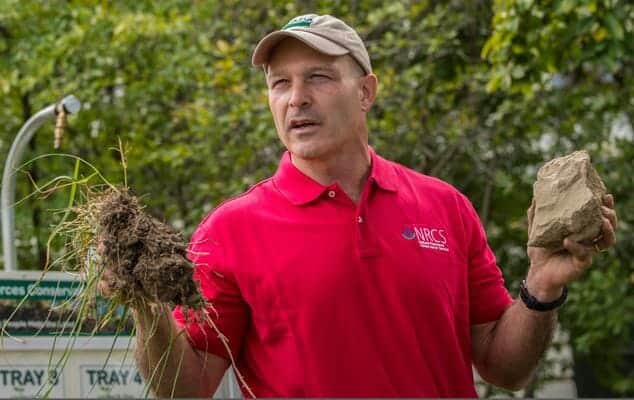Photo: NRCS Scientists Holding Up Two Soil Samples. US Department of Agriculture, Natural Resource Conservation Service
The recently released National Climate Assessment discussed the impacts of climate change on our nation’s water supply and agricultural productivity. The levels of uncertainty regarding the future of our water supply are troubling. Changes in precipitation patterns will intensify droughts and increase heavy downpours. Hotter, more extreme weather will disrupt how well and how much we can grow on farms. The reduction in the Sierra Mountain snowpack will further constrain California’s water supply. I want to read about ways to adapt to and mitigate against our water insecurity problem, and thankfully, one of those pathways is at our fingertips, or under your feet, or in your backyard—depending on your perspective.
Enter soil.
Under the right conditions, soil can act like a natural sponge on our farms and help our farmers be more water secure in times of water insecurity. Take a look at the two soil samples below. Notice the thick chocolate-y consistency of the sample on the left? That’s what healthy soil looks like—dense, full of leftover plant matter, long roots that soil sticks to, earthworms, and active microbes. The sample on the right looks more like a rock on the side of a highway—dry, compacted, chalky, void of life. That clump of dirt would crumble under the slightest bit of pressure.
Healthy soil has incredible water retention capacity. Keeping plant debris on a field helps break a raindrop’s fall, so instead of bouncing off the soil when it falls, it’s absorbed through the layer of plant matter. All the roots make soil more porous, allowing water to penetrate the farm instead of rushing off it. Regenerative agriculture practices like cover cropping and no-till provide the leftover plant debris and roots that make soil more absorbent. NRDC’s research shows that if the top 10 agriculture states practiced cover cropping on half of their corn and soybean farms, those states could retain an additional trillion gallons of water on their farms. That’s a lot of water! Increasing water retention capacity of farmland also means less water lost to runoff during rain events. This has the added benefit of reducing nutrient runoff from our farms, meaning less contamination of our drinking water supplies and reductions in harmful algal blooms across the country.
California is the top producer of agricultural products in the nation. But the production comes at a cost to California’s water supply. California’s agricultural sector uses 80% of the state’s publicly developed water supply. That level of use is unsustainable, and climate change will alter how much water our farms can use. Regenerative agriculture practices can […]
Full article: Building Roots for a More Water Secure California
More about healthy soil and groundwater:
Strips of prairie plants slow loss of soil, nutrients and water, double biodiversity
Can American soil be brought back to life?
Benefits of Groundwater Recharge Demonstrated in Lodi Vineyards
Diverse forests are stronger against drought
Plant roots go to extreme lengths to find water


